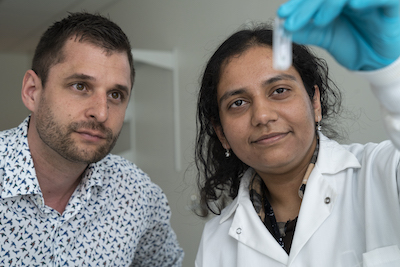In This Story
Peering into the body past skin and tissue to detect problems, spot disease, and make proper diagnoses challenges medical professionals, even with recent leaps in the technology. Ultrasound, for example, while reliable, may add or omit information, cannot see through bones, is not adapted for deep structures, and might show things to be of a size and shape—or in a location—that is not accurate.

George Mason University College of Engineering and Computing bioengineering team members, including recent Mason PhD Shrishti Singh, Assistant Professor Remi Veneziano, and Associate Professor Parag Chitnis, are clearing things up with advancements in what’s known as near-infrared photoacoustic imaging (NIR-PAI).
This technique combines the advantages of optical and ultrasound imaging to provide high-resolution anatomical and functional information about tissues. They are tackling the biggest hindrance to NIR-PAI—the limited availability of contrast agents—by using a novel contrast agent platform to improve imaging capabilities. It will result in improvements in everything from deep-tissue tumor imaging, lymph node imaging, and biopsies.
“This technology might give patients better diagnostics for colon cancer, pancreatic cancer, breast cancer, and more, and can improve their prognosis,” said Singh, who also has a master’s degree in biomedical engineering from the University of Bridgeport in Connecticut and an engineering degree from Ramaiah Institute of Technology in Bangalore, India.
The Mason team is making inroads with this important element of health diagnosis and treatment, and with funding from the Virginia Innovation Partnership Corporation (VIPC) Commonwealth Commercialization Fund, they are seeking to launch a startup to commercialize their developments.
The VIPC award totaled $75,000 and will largely be used to develop the technology further with Singh now working as a postdoctoral fellow. Along with Veneziano—her advisor—and Chitnis, Singh hopes to launch a company based on this technology.
In 2022 the three researchers participated in the Innovation Commercialization Assistance Program (ICAP), which assists Virginia-based tech-focused start-ups to get off the ground by teaching them to interview potential customers, get an understanding of the marketplace, and validate their business model.
The nonprofit operations arm of the Virginia Innovation Partnership Authority (VIPA), VIPC is the commercialization and seed stage economic development driver in the commonwealth that leads funding, infrastructure, and policy initiatives to support Virginia's innovators, entrepreneurs, startups, and market development strategies. VIPC collaborates with local, regional, state, and federal partners to support the expansion and diversification of Virginia’s economy.
